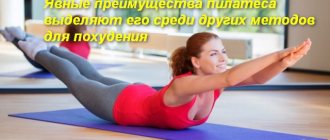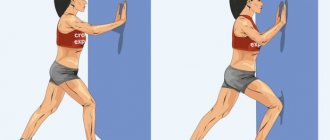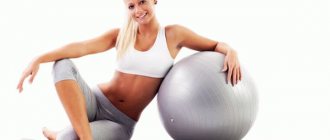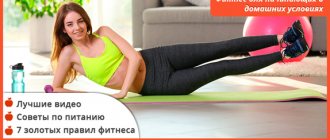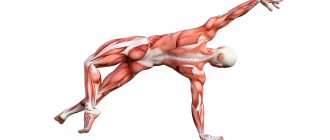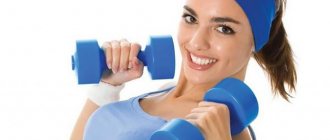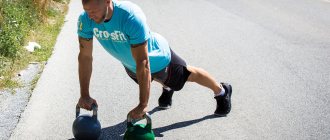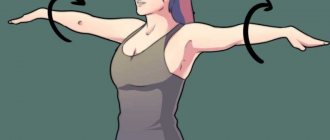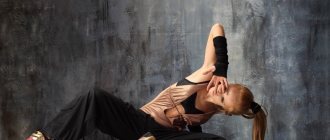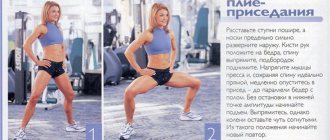Learning Pilates at home is easy. The main thing is to follow the technique of doing the exercises and listen to your feelings.
A system of exercises called “Pilates” helps make the body healthy, flexible and fit due to deep muscle development and the absence of shock loads on the joints (for example, jumping). It is ideal for those who do not like fuss and prefer to exercise at a measured pace, feeling the work of every muscle. If you are partial to yoga and stretching, you will definitely like Pilates. Another important advantage of such training is that it can be successfully carried out at home. Pilates at home is a simple and accessible way for everyone to improve their physical fitness.
Pilates classes can be recommended for people with different levels of physical fitness. If you have had injuries in the past, or have contraindications to high-intensity physical activity, start your sports journey with Pilates. It perfectly works the muscles of the whole body without unnecessarily loading the joints. Such classes are suitable for both young girls and middle-aged and older women. To perform Pilates exercises at home you will need a minimum of equipment. More on this later.
Uniqueness of the technique
Pilates gymnastics is a system of exercises in which movements are aimed at working the muscle groups of the deepest layers. Deep breathing, which “corresponds” to each movement, helps to achieve this effect. Slow pace, clear control of your body, concentration on each exercise are the distinctive features of Pilates.
Unlike other gymnastic innovations, anyone can do Pilates: the system has no contraindications. Men and women of all ages and fitness levels can achieve maximum training results. Let's list what they are:
- Stretching the joints and spine. Slow, well-calculated movements make the body flexible, giving joints mobility.
- Strengthening muscle fibers, “tightening” the skin.
- Weight correction. Thanks to the activation of metabolic processes, extra pounds are slowly but surely removed from the body.
- Improvement of the heart and blood vessels. Regular training allows the blood to be saturated with oxygen, which is necessary to nourish all organs and tissues. The walls of blood vessels become stronger and more elastic. Blood pressure is normalized and the functionality of the heart muscle is improved.
- Recovery after severe injuries. Slow and smooth movements “protect” from accidental injury, which is very important at the stage of rehabilitation after injury.
- Use in complex treatment of lumbar disc hernia.
- Strengthening the abdominal and thigh muscles will help pregnant women prepare for the upcoming birth and make it easier.
- Recovery after childbirth. Weakened muscles will quickly recover and become toned.
- Improved posture.
Distinctive features of Pilates exercises:
- “Soft” and gradual strengthening and stretching of muscles;
- The effect is achieved due to the quality of the movements, so their number is reduced;
- One exercise smoothly transitions into another: the movement is carried out without stopping;
- The correctness of movements consists of smoothness and softness;
- Exercises are performed with control of even and deep breathing;
- The technique involves “pumping” all muscle groups.
Regular exercise will improve your health, give you a good mood and a beautiful figure.
Advantages, disadvantages, contraindications
Using Pilates at home will strengthen your body and improve your spirit. The technique has undeniable advantages:
- The exercises are simple and do not require special physical skills;
- No special equipment is needed for training: beginners only need a mat;
- Detailed video tutorials can replace an instructor;
- Training simultaneously corrects the figure and performs a health function.
It is more difficult to name the disadvantages of the technique; there are practically none. This also applies to contraindications: everyone can practice. The exceptions are conditions in which any activity is harmful:
- Infectious diseases accompanied by increased body temperature;
- Bone tissue injuries: fractures, dislocations;
- Chronic diseases in the acute stage;
- Internal bleeding;
- Mental disorders.
These contraindications are only a temporary obstacle to training: after completing the course of treatment, you can begin performing Pilates exercises.
Necessary recommendations
If you are convinced that there are no contraindications and are determined to practice Pilates at home, read the recommendations of specialists. They will help make your classes more effective.
- Choose clothes made from natural fabrics that do not restrict movement;
- Train barefoot or in thin socks;
- Choose a mat that matches your height;
- Plan your classes so that no one disturbs you: you will need full concentration;
- Plan to train at the same time 3 times a week;
- Eat 1.5 hours before training;
- Don't miss classes;
- Accompany all movements with deep rhythmic breathing, in which the shoulders are lowered and the head is raised high;
- Follow the instructions from the video tutorials;
- During movements, stretch your spine, drawing in your stomach;
- Feeling tired is a reason to finish classes.
Special music used for Pilates classes will help you relax and concentrate.
When doing Pilates exercises for beginners, constantly listen to the sensations of your body: the presence of discomfort “speaks” of incorrectly performed movements.
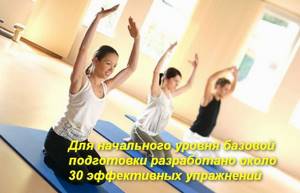
What are the benefits of Pilates?
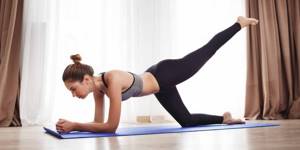
The main benefit of these exercises is that they restore the functionality of the spine and the depreciation of the intervertebral discs. Mobility and flexibility are restored to the joints. Dense, elastic and elongated muscles are formed without working out individual zones. The body, at the same time, acquires lightness and fit.
The advantages of Pilates are that the muscles are not pumped over when performed carefully and with small repetitions. Due to their lengthening and strengthening, the spine straightens, stopping “growing down”. In women, as a result of training, the pelvic muscles are strengthened, which prevents the occurrence of female diseases and bladder problems.
A straightened and elongated spine helps the internal organs fall into place and work properly. Regular exercise smoothes out the “orange peel” of cellulite, adds immunity and relieves stress. Anxiety goes away, sleep is restored and blood pressure normalizes. By breathing deeply, the blood is enriched with oxygen, accelerating metabolic processes. Abdominal work removes fat from the belly, making it flat and firm. After training, a feeling of deep, but not severe fatigue.
Basic complex
For the initial level of basic training, about 30 effective exercises have been developed. It is difficult to say which of them is more effective: each has undoubted advantages. Here is an example of several exercises that you can easily do on your own.
Warm-up
Remember that the rules of Pilates classes require a mandatory warm-up. Its task is to warm up the muscle mass, preparing it for further exercise. The length of the warm-up is 5-10 minutes.
- Lie on your back. Take a deep breath, tighten your abdominal muscles. Slowly raise your legs, gradually bending your knees, to chest level. When they “reach” your chest, clasp your knees with your hands. Exhale. Press your legs as close to your body as possible. Remain motionless in a fixed position to slowly take 3 inhalations and exhalations. Feel the stretch in all ligaments. Without haste, return your feet to the floor. Repeat the exercise twice.
- Without changing your position, from a lying position, bend your knees. Place your arms along your body. Raise your legs so that a right angle is formed with the help of your thigh and shin. From this position, slowly tilt both legs simultaneously to the right, then to the left. Throughout the exercise, keep your abdominal muscles tense while breathing deeply.
Alternative
With all that said, there are still a lot of yoga supporters. Therefore, the question arises again: what is better, yoga or Pilates? These currently fashionable trends have something in common, but there is also a fundamental difference. Similarities:
- Lack of fast movements and numerous repetitions.
- Development of endurance.
- Figure correction.
- Help with weight loss.
- Help in finding peace of mind.
- Similar exercise technique.
- Particular attention to breathing technique.
- Strengthening the nervous system.
- Improving metabolic processes in the body.
- Strengthening the immune system.
There are, of course, differences. What is yoga like:
Yoga is an old teaching; it dates back several thousand years. It combines the wisdom and experience of many generations. Pilates is relatively “young”, it is only about a hundred years old. Yoga has a deep philosophy that unites the body and self-awareness. It develops concentration and raises self-esteem. Exercises, called asanas, are performed for several minutes without changing postures. In yoga, special attention is paid to the spine and back.
The significant difference between both practices is that they have different breathing techniques. The goal of Pilates is to saturate the muscles with oxygen, and yoga helps you control your own body.
We can say with confidence that Pilates and yoga are two types of fitness that anyone can start doing, regardless of their physical fitness and age. And your own choice should be based on what the future athlete has a greater inclination towards. So, what to choose: yoga or Pilates is up to each individual.
There is another fashionable movement in fitness - callanetics.
The development of this technique belongs to the ballerina from Holland Callan Pinckney in the 80s of the last century. She came up with this complex when she found herself in a very unenviable position. After a long journey, the ballerina experienced pain in her back, knees and severe fatigue. In addition, she had to undergo surgery.
Thanks to this complex, all her pain went away, and the participation of surgeons in her fate was not needed. The ballerina herself became stronger and even stronger. Distinctive features of callanetics: the method is based on static exercises and is effective for those who already have good physical training. Not every beginner can “pull” it, since the load goes on all the muscles of the body. So if you want to take up callanetics, then it’s better to start your sports path with Pilates.
The pulse does not increase during exercise, as in Pilates, which means that the complex is quite suitable for people who suffer from cardiovascular diseases, so this method will only improve the health of people who decide to take up this type of fitness.
As for muscle mass, it does not grow in callanetics, but gets stronger.
The technique is somewhat different from yoga, which will undoubtedly have a positive effect on health if you practice constantly and purposefully.
Of course, there are contraindications, as in any sport.
In callanetics, as in Pilates, the emphasis is on large muscles: thighs, buttocks, abdomen.
Both methods act in the same direction, but each in its own way. By doing one type of fitness or another, you can lose extra pounds, provided that the classes are regular and not from time to time. Needless to say, the effectiveness of the exercises directly depends on the correct technique.
So everyone can make their choice in favor of Pilates or callanetics themselves, based on their personal preferences.
How Pilates affects weight loss: reviews from athletes
There are always a lot of reviews on forums and in various fitness groups about how Pilates affects the weight loss process. Reviews are sometimes contradictory and this is not without reason for the following reasons:
- Many athletes expect immediate results as soon as they start exercising. Pilates is an excellent method for losing weight, but it requires a lot of time, diligence and regularity.
- If you don’t follow the technique of doing the exercises and don’t monitor your breathing, it won’t do any good.
- If you eat incorrectly - rarely and in large quantities, not only will there be no effectiveness from exercise, but you should even expect a slight increase in your own weight.
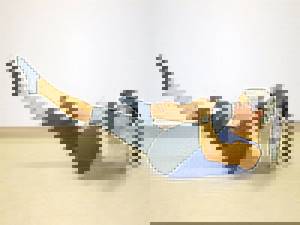
More on weight loss: things to consider
Regular physical activity is great because it not only helps you lose weight, but also improves your health. But in addition to proper technique and breathing, we must not forget about one more aspect - proper nutrition. If the diet is not balanced, then you should not hope for good results. Basic nutrition rules:
- Hearty breakfast. Cookies and coffee are not suitable here.
- You need to eat little and often.
- Carbohydrate foods are appropriate only in the first part of the day. This includes cereals, fruits, bread, confectionery, pasta, etc.
- You should not eat fatty foods before training - this can cause nausea during exercise.
- Eating meat and fish is recommended three hours before classes.
- After training, be sure to have a snack about half an hour later.
- You need to reduce your coffee consumption to a minimum.
- All types of carbonated drinks should be excluded from the diet.
- It is necessary to constantly maintain a drinking regime to maintain water balance.
- The use of natural juices is encouraged - preferably squeezed juice, as well as herbal infusions. You need to drink both during and after training.
Useful video - Pilates for home No. 1 from Natalia Papusha. Just repeat after her
Main part
- "Light touches"
Without changing your starting position after warming up, raise your legs, slightly bent at the knees, to the level of your stomach. Extend your feet, grouping your toes like ballerinas do. Lower your legs one at a time, touching the floor with your toes. Remember to keep your abs tense and your back straight.
Control your breathing: inhale - raise your leg, exhale - lower it. Each leg is “worked” up to 10 times.
- "Coordination"
The following exercise requires performing movements in a clear sequence:
- Lie down on the floor;
- Raise the top of the body;
- Your arms must be extended forward;
- The legs, straightened as much as possible, are raised to the level of a right angle;
- They are taken aside;
- Bend at the knee joints, maintaining a right angle;
- Slowly “pull up” your arms, gradually bending them at the level of your elbows;
- Lower the upper body to the floor.
The movements begin after a deep breath. Exhale while lowering your legs. The movement is repeated 7-8 times.
- "Knee Raises"
Get down on all fours. Make sure you have the correct body position during the starting position: your back is straight, your shoulder blades are in line with your spine, your toes are touching the floor.
Inhale, pull your stomach in tightly, raise your knees 3-4 cm from the floor. Repeat 6 times.
- "Circle of hips"
Move to your right side. Place your left leg in front, slightly bending the knee. The load is performed by the straight right leg. It is raised 10-15 cm from the floor. Using the muscle mass located on the inner thighs, rotational movements are made. To achieve the desired effect, do 10 rotations in each direction. Then change your body position, “giving the work” to your left leg.
- "Bridge on the back"
Roll over onto your back. Place your arms along your body, focusing on your legs bent at the knees. Place your feet hip-width apart. Raise your buttocks, and from this position make 8 swings with one straightened leg. Repeat the exercise, changing the “active” leg.
- "Batman"
Roll over onto your side. Focus on your arm extended parallel to your body, and stretch your toes. Swing your “active” leg (the one on top) so that your back remains straight and your hips are neutral. 12 swings are done on each side.
- "Flight"
Roll over onto your stomach. Stretch your toes while extending your arms straight to the sides.
Raise your upper back as high as possible. In parallel with this movement, the arms are raised and pulled back. The head stretches upward, the tips of the fingers stretch back. Lower yourself to the floor with your back straight. Repeat the movement 8 times.
- "Swimming"
Stay on your stomach. Raise your arms, legs, shoulders and head straight and tense at the same time. After 5 repetitions, start “swimming”. Imitating the corresponding movements, raise your arms and legs as high as possible. Make sure your back remains straight and your limbs and abs tense.
- "Clam"
Turn onto your side. Bend your knees and press them tightly together. Raise your top (“active”) leg as high as possible without moving your hips and buttocks.
- "Breast expander"
Stand up. Pick up lightly weighted dumbbells. The exercise is performed simultaneously with 2 straightened arms, making movements in the following sequence:
- Forward;
- To the sides;
- Down.
Requires 15 repetitions.
Tips for beginners and how to practice correctly
Like any new activity that a person begins to do for the first time, the Pilates exercise system for beginners should begin with general familiarization and introductory classes. To do this, you should use the services of a professional trainer or instructor. However, thanks to the Internet, today it is not at all necessary to visit the training room to master the popular complex. If you wish, you can perform Pilates at home, not only by reading the sequence and technique of the exercises, but also by watching videos and photographs.
However, Pilates is considered a rather complex complex in terms of technique. In order not to nullify all your efforts, try to adhere to the basic rules , which are relevant, first of all, for beginners:
- pay attention to your breathing during training - breathe through your chest , trying to open your ribs wider when you inhale and contract your muscles as much as possible when you exhale
- constantly control your abs - keep it tense throughout the entire session, drawing energy and distributing it to the entire body, all movements should come from the abs
- follow the recommendations as accurately as possible and take the correct position - an uncomfortable or incorrect position can not only not be beneficial, but also harm the body
- shoulders , during most exercises, should be lowered - this is of great importance for proper breathing, because with lowered shoulders, the chest opens wider
- keep your head straight without throwing your chin back or pressing your chin to your chest - when doing exercises on the floor or on all fours, this allows you to use muscle groups that are difficult to work under normal conditions
- try to stretch your spine throughout all exercises - you increase the distance between the spinal discs, making your body more flexible and mobile
There are a number of other recommendations that a Pilates trainer can give you. It is enough to attend two or three training sessions to understand the basic rules and be able to further perform Pilates exercises at home, without the constant supervision of an instructor.
System, rules for performing exercises
Regardless of where you decide to practice, remember that Pilates is a special system, the effectiveness of which is achieved only if certain rules are followed.
If you train in a fitness center, the instructor will definitely tell you about them. If you decide to study on your own, remember these rules:
- Correct breathing is always deep and rhythmic;
- The abdominal muscles remain tense, regardless of whether you inhale or exhale;
- The source of energy in Pilates is a tense abs: control it throughout the entire workout;
- When working your back muscles, always lower your shoulders;
- A straight position of the head and back will help to further work out the muscular frame of the neck and shoulder area;
- Try to use every movement to “stretch” your spine.
Pilates is an opportunity to strengthen the body while improving the spirit. It is not difficult to achieve effective results: simple exercises must be done carefully, focusing on each movement. Regular training will give you a beautiful body, provide you with a good mood and excellent well-being.
History of the procedure
Relatively recently, Russians began to give preference to complex exercises called Pilates. For the first time they were used by pop stars and public people, although the system was created 100 years ago.
Developed a comprehensive program for D.H. Pilates. This weak and sickly German boy overcame asthma and his other ailments thanks to physical exercise.
At the age of 14, he fully recovered, had the appearance of a model and the body of an athlete. At a young age, the guy moved to the USA and began to promote his training system. Over time, Pilates has been transformed, adjustments have been made, but the dogmas laid down by the founder remain unchanged.
